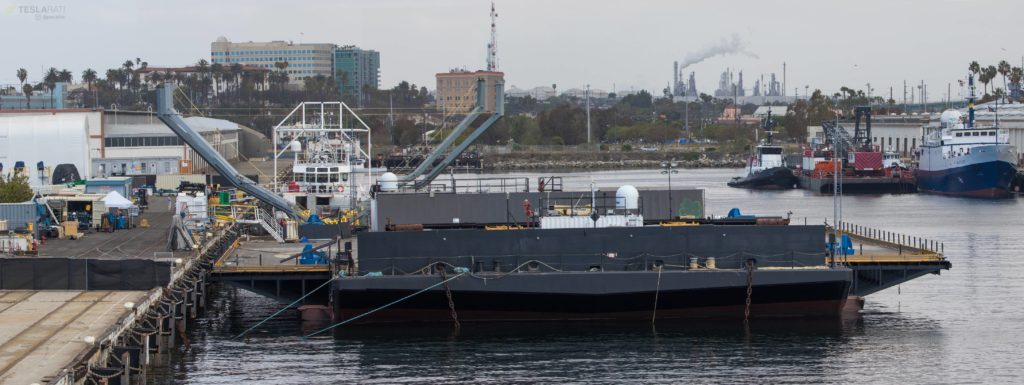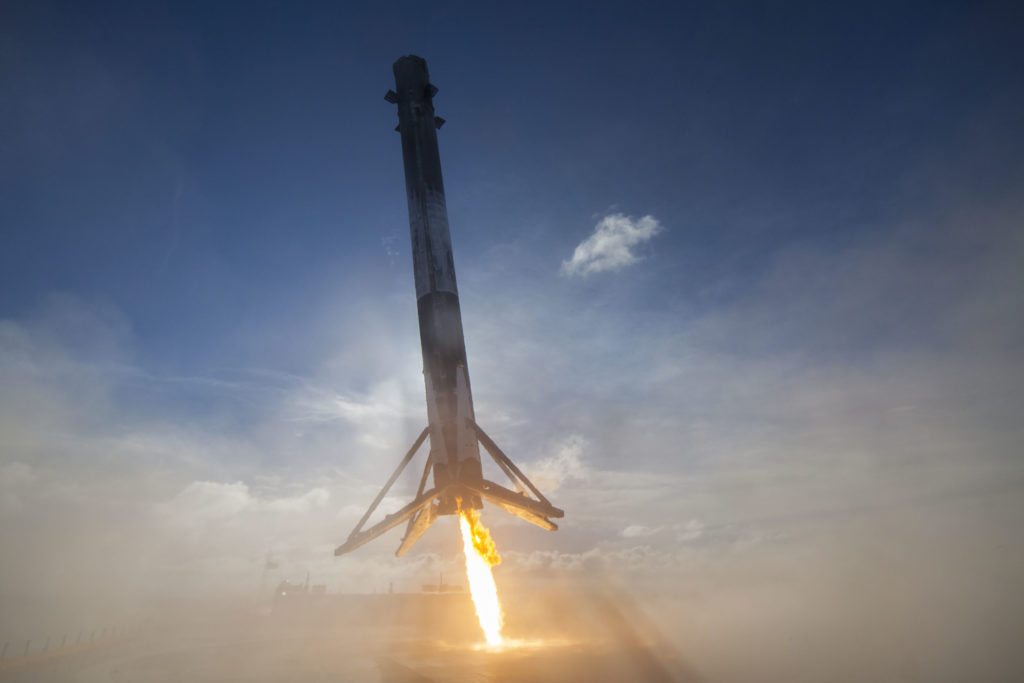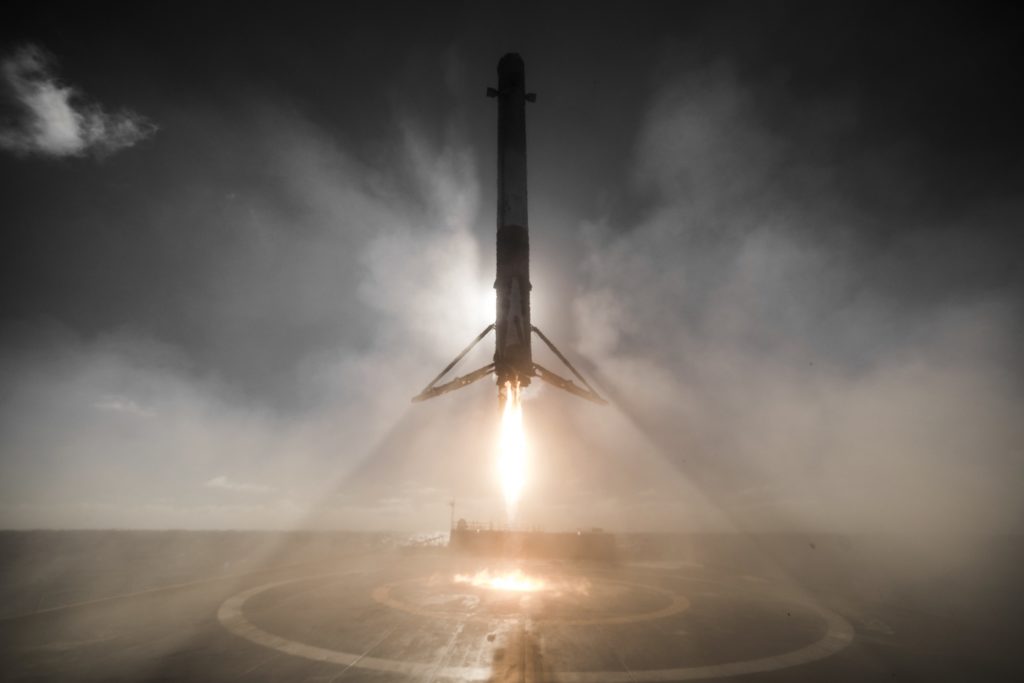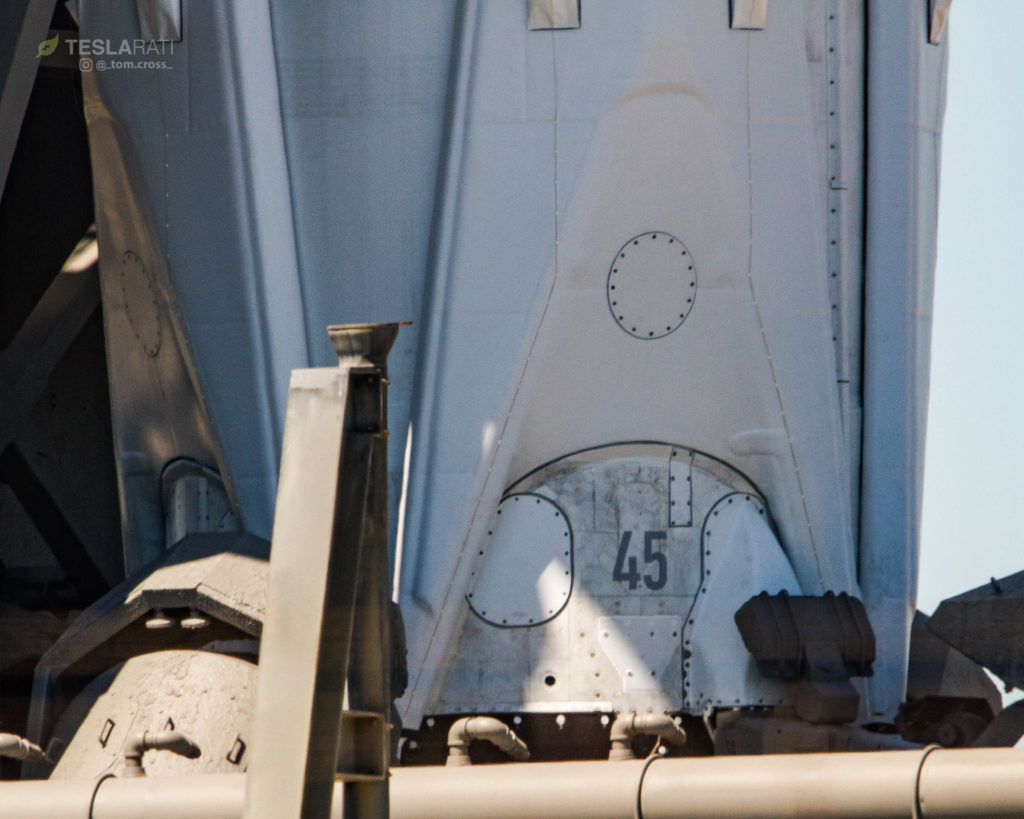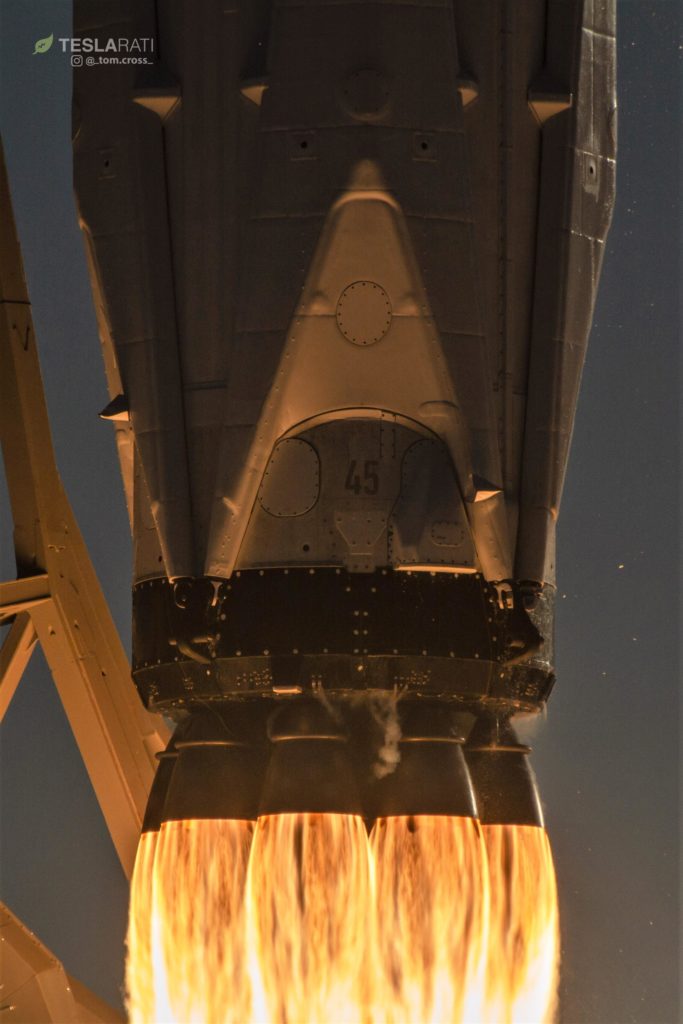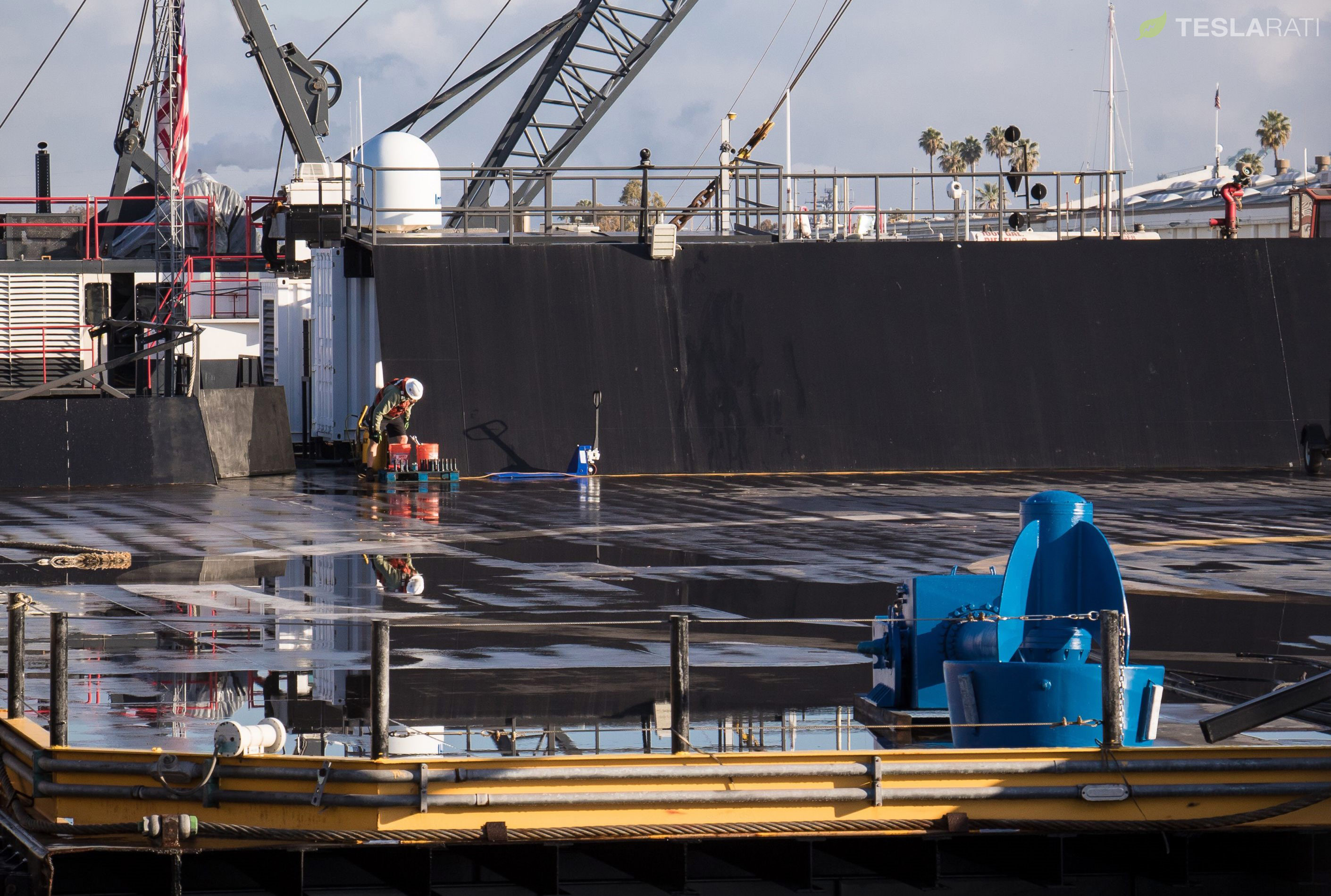

News
SpaceX’s drone ships near return-to-action with Block 5 Falcon 9 landings
Teslarati photographer Pauline Acalin’s recent trips to drone ship Just Read The Instructions’ berth in Port of San Pedro shows that SpaceX technicians are nearly done preparing the hibernating vessel for a return to Falcon 9 rocket recoveries in the Pacific Ocean, a ten-month drought likely to end for good on July 20th.
Although it’s hard to believe, SpaceX’s West Coast autonomous spaceport drone ship (ASDS) has been effectively marooned at its Port of Los Angeles berth for more than nine full months, with the vessel’s last recovery occurring just after the October 9 launch of ten Iridium NEXT satellites, the fourth of five SpaceX Vandenberg launches in 2017 (and the fourth of four West Coast booster landings).
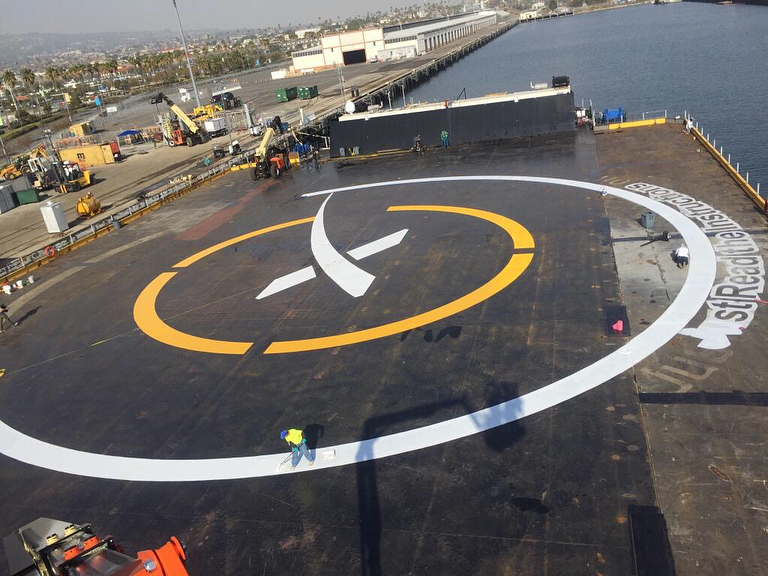
SpaceX’s West coast drone ship Just Read The Instructions getting some much needed fresh paint in 2017. (Instagram, anonymous)
Three months after that October mission and booster recovery, SpaceX expended their next California launch and marked the beginning of a streak of eight missions where flight-proven Block 3 and 4 boosters could have been recovered but no attempts were made. While intermixed with the spectacle of Falcon Heavy’s dual side booster landings at LZ-1, the debut launch and recovery of Falcon 9 Block 5, and two other Block 4 booster recoveries, the majority of SpaceX’s launches since December 2017 have been treated as expendable – put simply, the company decided that recovering and refurbishing twice-flown boosters of older Falcon 9 blocks was not worth the effort and expense.
Instead, those well-worn boosters were expended in the Pacific and Atlantic Oceans after partially supporting a series of experimental tests designed to gather additional data on the recovery envelope of SpaceX’s partially reusable rockets. The rationale makes sense – SpaceX fundamentally sacrificed some of its older, less-reusable Falcon 9 boosters for the sake of knowledge that may allow their highly reusable Falcon 9 Block 5 predecessors a better chance of successfully landing even after exceptionally fast, hot, and high-energy recoveries, a necessity if the upgraded rockets are to be reused 10 to 100 times, as is the goal.
Although Just Read The Instructions spent several months without a full complement of maneuvering thrusters, thanks in part to efforts to keep its besieged East coast sister Of Course I Still Love You operational, photographer Pauline Acalin’s photos over the last several months show that the vessel now has four full thrusters installed and ready to bring it back into rocket recovery action in the Pacific Ocean.
- SpaceX’s drone ship Just Read The Instructions and fairing catcher Mr Steven at their Port of San Pedro berths, May 2018. Note the four bright blue thrusters visible aboard JRTI, three installed and one on deck. (Pauline Acalin)
- The aggressive Atlantic Ocean landing of Thaicom-8’s Falcon 9 first stage. (SpaceX)
- Iridium-1’s successful and scenic landing on Pacific drone ship JRTI, January 2017. This could be an increasingly rare occurrence in the Pacific, thanks to SpaceX’s new land-based landing zone. (SpaceX)
Still, the abrupt return to expendable rocket launches after a year – 2017 – filled to the brim with 18 of 18 successful launches and 14 of 14 successful landings led to a decidedly fascinating vein of disapproval in the SpaceX enthusiast and broader spaceflight fan communities – people had grown accustomed to the adrenaline-soaked thrill of routine Falcon 9 rocket landings. Some expressed worries that regularly and intentionally expending large hunks of metal in the ocean could harm their ecosystems and was tantamount to littering. None the wiser, every other launch provider in the world continues to expend all of their rocket boosters without any attempts at recovery like the nearly all non-Shuttle rocket launches in the past six decades, and their tepidly reusable next-generation rockets are unlikely to even begin attempting hardware recovery until the mid-2020s at the earliest.
Frankly, SpaceX’s abrupt successes with orbital-class rocket recovery struck a chord with observers, demonstrating just how intuitive attempting to recover expensive rocket hardware really is, while also bringing into clear focus the actual insanity of failing to try and of the seemingly ad-hoc rationalization of expendable rocketry. Thankfully, we still have SpaceX, and the company’s spate of rocket booster sacrifices is likely just one expendable launch away from coming to an effective end for the indefinite future, with that particular launch – CRS-15 – scheduled less than two weeks from now, on June 29th.
- B1045, tasked with launching NASA’s TESS exoplanet observatory, roughly 24 hours before liftoff. (Tom Cross)
- After launching in April 2018, B1045 landed on OCISLY and is being refurbished for a second launch in just 5 days, on June 29. (Tom Cross)
After CRS-15, which will probably see its twice-flown Block 4 booster expended in the Atlantic, a combination of Block 5 Falcon 9s and Heavies will theoretically bring to an end the practice of expending orbital rocket boosters, at least on SpaceX’s watch. Considering that the upgraded boosters have been designed and built to launch as many as ten times with minimal refurbishment and potentially 100+ times with regular maintenance, the opportunity cost of an expended Block 5 rocket booster is so high that it is difficult to imagine SpaceX will be easily swayed to expend one until it’s flown at least several times prior.
We here at Teslarati eagerly await the imminent demise of expendable rockets, set to begin in earnest – at least for SpaceX – around July 19th and 20th with two Falcon 9 Block 5 launches on two coasts, one with Telstar 19V (Florida) and the other with Iridium-7 (California).
Follow us for live updates, peeks behind the scenes, and photos from Teslarati’s East and West coast photographers.
Teslarati – Instagram – Twitter
Tom Cross – Twitter
Pauline Acalin – Twitter
Eric Ralph – Twitter
Elon Musk
Tesla investors will be shocked by Jim Cramer’s latest assessment
Jim Cramer is now speaking positively about Tesla, especially in terms of its Robotaxi performance and its perception as a company.

Tesla investors will be shocked by analyst Jim Cramer’s latest assessment of the company.
When it comes to Tesla analysts, many of them are consistent. The bulls usually stay the bulls, and the bears usually stay the bears. The notable analysts on each side are Dan Ives and Adam Jonas for the bulls, and Gordon Johnson for the bears.
Jim Cramer is one analyst who does not necessarily fit this mold. Cramer, who hosts CNBC’s Mad Money, has switched his opinion on Tesla stock (NASDAQ: TSLA) many times.
He has been bullish, like he was when he said the stock was a “sleeping giant” two years ago, and he has been bearish, like he was when he said there was “nothing magnificent” about the company just a few months ago.
Now, he is back to being a bull.
Cramer’s comments were related to two key points: how NVIDIA CEO Jensen Huang describes Tesla after working closely with the Company through their transactions, and how it is not a car company, as well as the recent launch of the Robotaxi fleet.
Jensen Huang’s Tesla Narrative
Cramer says that the narrative on quarterly and annual deliveries is overblown, and those who continue to worry about Tesla’s performance on that metric are misled.
“It’s not a car company,” he said.
He went on to say that people like Huang speak highly of Tesla, and that should be enough to deter any true skepticism:
“I believe what Musk says cause Musk is working with Jensen and Jensen’s telling me what’s happening on the other side is pretty amazing.”
Tesla self-driving development gets huge compliment from NVIDIA CEO
Robotaxi Launch
Many media outlets are being extremely negative regarding the early rollout of Tesla’s Robotaxi platform in Austin, Texas.
There have been a handful of small issues, but nothing significant. Cramer says that humans make mistakes in vehicles too, yet, when Tesla’s test phase of the Robotaxi does it, it’s front page news and needs to be magnified.
He said:
“Look, I mean, drivers make mistakes all the time. Why should we hold Tesla to a standard where there can be no mistakes?”
It’s refreshing to hear Cramer speak logically about the Robotaxi fleet, as Tesla has taken every measure to ensure there are no mishaps. There are safety monitors in the passenger seat, and the area of travel is limited, confined to a small number of people.
Tesla is still improving and hopes to remove teleoperators and safety monitors slowly, as CEO Elon Musk said more freedom could be granted within one or two months.
News
Tesla launches ultra-fast V4 Superchargers in China for the first time
Tesla has V4 Superchargers rolling out in China for the first time.

Tesla already has nearly 12,000 Supercharger piles across mainland China. However, the company just initiated the rollout of the ultra-fast V4 Superchargers in China for the first time, bringing its quick-charging piles to the country for the first time since their launch last year.
The first batch of V4 Superchargers is now officially up and running in China, the company announced in a post on Chinese social media outlet Weibo today.
The company said in the post:
“The first batch of Tesla V4 Superchargers are online. Covering more service areas, high-speed charging is more convenient, and six-layer powerful protection such as rain and waterproof makes charging very safe. Simultaneously open to non-Tesla vehicles, and other brands of vehicles can also be charged. There are more than 70,000 Tesla Superchargers worldwide. The charging network layout covers 100% of the provincial capitals and municipalities in mainland China. More V4 Superchargers will be put into use across the country. Optimize the charging experience and improve energy replenishment efficiency. Tesla will accompany you to the mountains, rivers, lakes, and seas with pure electricity!”
The first V4 Superchargers Tesla installed in China are available in four cities across the country: Shanghai, Zhejiang, Gansu, and Chongqing.

Credit: Tesla China
Tesla has over 70,000 Superchargers worldwide. It is the most expansive and robust EV charging network in the world. It’s the main reason why so many companies have chosen to adopt Tesla’s charging connector in North America and Europe.
In China, some EVs can use Tesla Superchargers as well.
The V4 Supercharger is capable of charging vehicles at speeds of up to 325kW for vehicles in North America. This equates to over 1,000 miles per hour of charging.
Elon Musk
Elon Musk hints at when Tesla could reduce Safety Monitors from Robotaxi
Tesla could be reducing Safety Monitors from Robotaxi within ‘a month or two,’ CEO Elon Musk says.

Elon Musk hinted at when Tesla could begin reducing Safety Monitors from its Robotaxis. Safety Monitors are Tesla employees who sit in the front passenger seat during the driverless rides, and are there to ensure safety for occupants during the earliest rides.
Tesla launched its Robotaxi fleet in Austin last Sunday, and after eight days, videos and reviews from those who have ridden in the driverless vehicles have shown that the suite is safe, accurate, and well coordinated. However, there have been a few hiccups, but nothing that has put anyone’s safety in danger.
A vast majority — close to all of the rides — at least according to those who have ridden in the Robotaxi, have been performed without any real need for human intervention. We reported on what was the first intervention last week, as a Safety Monitor had to step in and stop the vehicle in a strange interaction with a UPS truck.
Watch the first true Tesla Robotaxi intervention by safety monitor
The Tesla and UPS delivery truck were going for the same street parking space, and the Tesla began to turn into it. The UPS driver parallel parked into the spot, which was much smaller than his truck. It seemed to be more of an instance of human error instead of the Robotaxi making the wrong move. This is something that the driverless cars will have to deal with because humans are aggressive and sometimes make moves they should not.
The Safety Monitors have not been too active in the vehicles. After all, we’ve only seen that single instance of an intervention. There was also an issue with the sun, when the Tesla braked abnormally due to the glare, but this was an instance where the car handled the scenario and proceeded normally.
With the Robotaxi fleet operating impressively, some are wondering when Tesla will begin scaling back both the Safety Monitors and Teleoperators that it is using to ensure safety with these early rides.
CEO Elon Musk answered the inquiry by stating, “As soon as we feel it is safe to do so. Probably within a month or two.”
As soon as we feel it is safe to do so.
Probably within a month or two. We continue to improve the Tesla AI with each mile driven.
— Elon Musk (@elonmusk) June 30, 2025
Musk’s response seems to confirm that there will be fewer Teleoperators and Safety Monitors in the coming months, but there will still be some within the fleet to ensure safety. Eventually, that number will get to zero.
Reaching a point where Tesla’s Robotaxi is driverless will be another significant milestone for the company and its path to fully autonomous ride-sharing.
Eventually, Tesla will roll out these capabilities to consumer-owned vehicles, offering them a path to generate revenue as their car operates autonomously and completes rides.
For now, Tesla is focusing on perfecting the area of Austin where it is currently offering driverless rides for just $4.20 to a small group of people.
-

 News5 days ago
News5 days agoTesla Robotaxi’s biggest challenge seems to be this one thing
-

 News2 weeks ago
News2 weeks agoTesla confirms massive hardware change for autonomy improvement
-

 Elon Musk2 weeks ago
Elon Musk2 weeks agoElon Musk slams Bloomberg’s shocking xAI cash burn claims
-

 News2 weeks ago
News2 weeks agoTesla China roars back with highest vehicle registrations this Q2 so far
-

 News2 weeks ago
News2 weeks agoTesla features used to flunk 16-year-old’s driver license test
-

 News2 weeks ago
News2 weeks agoTexas lawmakers urge Tesla to delay Austin robotaxi launch to September
-

 News2 weeks ago
News2 weeks agoTesla dominates Cars.com’s Made in America Index with clean sweep
-

 News2 weeks ago
News2 weeks agoTesla’s Grok integration will be more realistic with this cool feature

